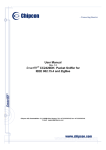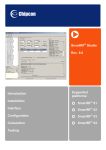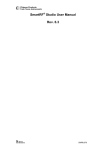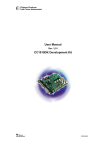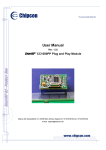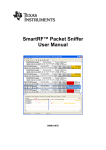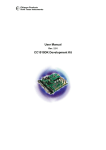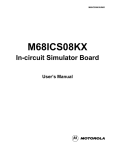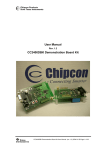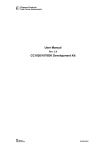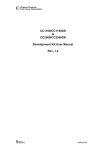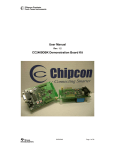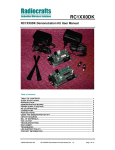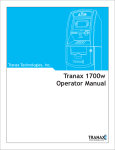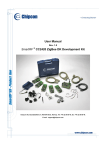Download using the development kit
Transcript
User Manual Rev. 2.0 CC1050DK Development Kit SWRU053 Page 1 of 20 Table of contents INTRODUCTION ....................................................................................................................... 3 EVALUATION BOARD ............................................................................................................. 4 DESCRIPTION ........................................................................................................................... 4 LAYOUT SKETCHES ................................................................................................................... 7 ASSEMBLY DRAWING ................................................................................................................ 9 CIRCUIT DIAGRAM ................................................................................................................... 10 BILL OF MATERIALS ............................................................................................................... 114 USING THE DEVELOPMENT KIT.......................................................................................... 17 SWRU053 Page 2 of 20 Introduction The CC1050 single chip transmitter includes many features and great flexibility, which makes the chip suitable for a very large number of applications and system requirements. The CC1050DK Development Kit is designed to make it very easy for the user to evaluate transmitter performance and in short time develop his own applications. The Development Kit includes one evaluation board with a complete CC1050 transmitter, voltage regulator and PC interface circuitry. Using the evaluation board connected to a PC running the SmartRF® Studio software, various system parameters can be changed and tested by keystrokes. Technical features: - RF power up to 12/8 dBm (433/868 MHz) programmable in 1 dB steps - Logic level data input (Manchester coded or NRZ) - Logic level synchronisation clock output - All set-up controlled by PC - Selectable 3 V or 4-10 Vunregulated voltage supply inputs This user manual describes how to get started with the Development Kit. You will also find detailed description of the evaluation board and advice how to develop your own applications. For details on how to use the SmartRF® Studio software please refer to the SmartRF® Studio User Manual. Your SmartRF® CC1050DK Development Kit should contain the following items: Kit contents Item Number of articles Evaluation Board (CC5000EB) 1 PC parallel port extension cable (25-pin D-sub, male-female, 3m) 1 Adapter (SMA male-BNC female) 3 Antenna (50Ω, λ/4 monopole, SMA male) 1 Quick Start User Manual 1 CC1050 sample kit 1 The evaluation board includes a significant number of components for great flexibility. However, only a minor part of these components are required in an actual application. Check the datasheet for a typical application circuit. SWRU053 Page 3 of 20 Evaluation Board The kit includes an Evaluation Board (CC1050EB) with the following items: • A SmartRF® CC1050 chip. • Necessary external surface mounted devices, SMDs, for the chip. • Voltage regulator 4 –10 V to 3V regulated voltage. • Possibilities to apply a 3 V voltage source directly (chosen by the switch on the board). • Voltage-level interface circuits between the CC1050 chip (3 V) and the parallel port of the computer (5 V). • Connector for a PC parallel port cable. • Connector for antenna, modulation data in and synchronisation clock out. • Pin connector for interfacing to MCU This board is designed for great flexibility so that you can evaluate the circuit performance for several circuit configurations, and in development of your own applications. The evaluation board is distributed in two versions, and the difference is the frequency band of operation. The two versions are optimised for 433 MHz and 868 MHz to cover the two licence free band in Europe. The operating frequency band is marked on the Evaluation Board. Description The evaluation circuit board constitutes of three main parts. These are the RF-section, the voltage supply and the PC-interface. The PC-interface contains voltage level shift circuit, which buffers the control lines. Voltage supply You can chose between applying a 4-10 V non-regulated supply voltage or a 3 V regulated supply voltage by setting a switch on the board (SPDT). If a non-regulated supply voltage is applied, an on board regulator generates a regulated 3 V supply. A diode prevents damage if wrong polarity is used for the non-regulated input. The connector has five contacts, which is shown below. In addition to the three supply voltage contacts, there are two contacts, which can be used to measure the DC current to the CC1050 chip. A short jumper is placed between these two contacts for the circuit to work. If you want to measure the DC current, replace the jumper with an amperemeter (as shown in the figure below). The current range is from 0 to 26 mA. SWRU053 Page 4 of 20 4-10V 0V 3V A Iout Iin Figure 1: The power connector with an amperemeter attached. RF-section The RF section consists of a CC1050 chip with external components. The different components are explained below. The loop filter The CC1050 has integrated the loop-filter and shaping features on-chip. For flexibility it is also possible to use an external loop-filter. The PLL loop filter contains the components C5C6 and R2. However, in most cases the internal filter will give the optimum performance. The loop filter is connected to the same pin as the monitoring of the lock indicator. When external loop-filter is added, the R80 must be removed to avoid conflict with the lock line connected to the parallel port. The LOCK signal A LOCK signal is connected to the parallel port interface to be monitored by the software. The signal tells you if the synthesiser frequency is in lock. It is also available at P4, and is active high. This digital output can also be configured to other functions, as control signal for external PA. Please see the data sheet for details. Note: To monitor this signal CC1050 must be configured to take out this signal on CHP_OUT. This is the default setting of SmartRF Studio. If external loop filter is added the lock signal cannot be used due to the loop filter is connected to the same pin. DI and DCLK The modulation input (DI) and the synchronisation output (DCLK) is connected to separate connectors. The connectors are of SMA female type. The data to be sent can be of either Manchester or NRZ. The Manchester code ensures that the signal has no DC component. The Manchester code is based on transitions; a “0” is encoded as a low-to-high transition, a “1” is encoded as a high-to-low transition. See figure below. Maximum data-rate is 38.4 kbit/s SWRU053 Page 5 of 20 giving a baud rate of 76.8 kbaud that is chosen in the software. For NRZ the baud rate is equal to the bit rate and is maximum 76.8 kbit/s. Please have in mind that the DI line must be of NRZ format even for Manchester mode selection. The encoding to Manchester is in this mode done internally by CC1050. The CC1050 has an internal clock synchronisation circuit that can be monitored on DCLK. The relationship between DI and DCLK is given in the CC1050 data sheet. PA matching The output-matching network is optimised for either 433 MHz or 868 MHz operation. The component values are calculated in the software program, and consist of L2, C1 and C2. Using the specified component values for the output match will give an optimum match at the specified operating frequency. Minor tuning of the component values may be necessary to compensate for layout parasitics at other frequencies or other layouts. A T-type LC-filter is used for reducing the harmonics. See Application note AN028 Improved LC-filter for details. The crystal oscillator The crystal frequency, X1, is set to 14.7456 MHz. The crystal oscillator circuit has a trimmer capacitor, CT52, which reduces the initial tolerance of the crystal to zero by careful adjustment using a precision frequency counter. The crystal used at this board has ±10 ppm accuracy and ±10 ppm over the –10 to +70 °C temperature range. The crystal oscillator has an AC coupled (C51) test pin for external clock injection, TP1. Be sure to remove the crystal when an external clock is used. The external clock should have amplitude of 1-3 Vpp. The loading capacitors are designed for a 16 pF crystal load. SWRU053 Page 6 of 20 Layout sketches SWRU053 Page 7 of 20 SWRU053 Page 8 of 20 Assembly drawing SWRU053 Page 9 of 20 Circuit diagram SWRU053 Page 10 of 20 SWRU053 Page 11 of 20 SWRU053 Page 12 of 20 SWRU053 Page 13 of 20 Bill of materials RF Part 433 MHz Reference Description Value Part C1 Capacitor 0603 12 pF C_12P_0603_NP0_G_50 C10 Capacitor 0603 220 pF C_220P_0603_NP0_G_50 C103 Capacitor, tantal 3.3 uF C_3U3_TAN_B C106 Capacitor 0603 33 nF C_33N_0603_X7R_K_25 C11 Capacitor 0603 82 pF C_82P_0603_NP0_G_50 C12 Capacitor 0603 33 nF C_33N_0603_X7R_K_25 C13 Capacitor 0603 1 nF C_1N0_0603_X7R_K_50 C14 Capacitor 0603 33 nF C_33N_0603_X7R_K_25 C2 Capacitor 0603 6.8 pF C_6P8_0603_NP0_C_50 C3 Capacitor 0603 18 pF C_18P_0603_NP0_G_50 C4 Capacitor 0603 15 pF C_15P_0603_NP0_G_50 C5 C51 Not Used Capacitor 0603 1 nF C_1N0_0603_X7R_K_50 C6 Not Used C7 Not Used C8 Not Used C9 Not Used C71 Capacitor 0603 3.9 pF C72 C_3P9_0603_NP0_G_50 Not Used CT52 Trimmer Capacitor C_3-10P_TRIM_NP0 L1 Inductor, 0603 33 nH L_33N_0603_KL73 L2 Inductor, 0805 6.2 nH L_6N2_0805_J L4 EMI filter bead L71 Inductor 0805 47 nH L_47N_0805_J L72 Inductor 0805 47 nH L_47N_0805_J R1 Resistor 0603 82 kΩ R_82K_0603_F BLM18HG102SN1D R2 Not Used R51 Not Used 0Ω R80 Resistor 0603 TP1 Testpoint TESTPIN U1 Single chip transmitter CC1050 X1 Crystal, HC-49-SMD X14.7456/10/10/10/16 SWRU053 R_0_0603 Page 14 of 20 RF Part 868 MHz Reference Description Value Part C1 Capacitor 0603 4.7 pF C_4P7_0603_NP0_C_50 C10 Capacitor 0603 220 pF C_220P_0603_NP0_G_50 C103 Capacitor, tantal 3.3 uF C_3U3_TAN_B C106 Capacitor 0603 33 nF C_33N_0603_X7R_K_25 C11 Capacitor 0603 82 pF C_82P_0603_NP0_G_50 C12 Capacitor 0603 33 nF C_33N_0603_X7R_K_25 C13 Capacitor 0603 1 nF C_1N0_0603_X7R_K_50 C14 Capacitor 0603 33 nF C_33N_0603_X7R_K_25 C2 Capacitor 0603 5.6 pF C_5P6_0603_NP0_C_50 C3 Capacitor 0603 18 pF C_18P_0603_NP0_G_50 C4 Capacitor 0603 15 pF C_15P_0603_NP0_G_50 C5 C51 Not Used Capacitor 0603 1 nF C6 C_1N0_0603_X7R_K_50 Not Used C7 Capacitor 0603 6.8 pF C_6P8_0603_NP0_C_50 C8 Capacitor 0603 6.8 pF C_6P8_0603_NP0_C_50 C9 Not Used C71 Capacitor 0603 2.2 pF C_2P2_0603_NP0_C_50 C72 Capacitor 0603 2.2 pF C_2P2_0603_NP0_C_50 CT52 Trimmer Capacitor L1 Inductor, 0603 5.6 nH L_5N6_0603_KL73 L2 Inductor, 0805 2.5 nH L_2N5_0805_J L4 EMI filter bead L71 Inductor 0805 15 nH L_15N_0805_J L72 Inductor 0805 15 nH L_15N_0805_J R1 Resistor 0603 82 kΩ R_82K_0603_F C_3-10P_TRIM_NP0 BLM18HG102SN1D R2 Not Used R51 Not Used 0Ω R80 Resistor 0603 TP1 Testpoint TESTPIN U1 Single chip transmitter CC1050 X1 Crystal, HC-49-SMD X14.7456/10/10/10/16 SWRU053 R_0_0603 Page 15 of 20 Voltage Regulator Reference Description Value Part C101 Capacitor, tantal 3.3 uF C_3U3_TAN_B C102 Capacitor, tantal 3.3 uF C_3U3_TAN_B D1 Diode, Si BAT254 S1 SPDT switch SWITCH_SPDT U2 Voltage regulator LP2981 PC Interface Reference Description Value Part C104 Capacitor 0603 33 nF C_33N_0603_X7R_K_25 Q1 BJT, Si, NPN, small signal BC846 Q2 BJT, Si, NPN, small signal BC846 R101 Resistor 0603 10 kΩ R_10K_0603_G R102 Resistor 0603 10 kΩ R_10K_0603_G R103 Resistor 0603 10 kΩ R_10K_0603_G R104 Resistor 0603 10 kΩ R_10K_0603_G R105 Resistor 0603 10 kΩ R_10K_0603_G R106 Resistor 0603 10 kΩ R_10K_0603_G R107 Resistor 0603 10 kΩ R_10K_0603_G R108 Resistor 0603 10 kΩ R_10K_0603_G R109 Resistor 0603 100 kΩ R_100K_0603_G R110 Resistor 0603 10 kΩ R_10K_0603_G R111 Resistor 0603 0 kΩ R_0_0603 R112 Resistor 0603 0 kΩ R_0_0603 R113 Resistor 0603 0 kΩ R_0_0603 R114 Resistor 0603 100 kΩ R_100K_0603_G R115 U3 Not Used Hex inverter, oc 74HC05 SWRU053 Page 16 of 20 Evaluation board Reference Description Value Part H1 Circuit Board Support Distance 12.5mm H2 Circuit Board Support Distance 12.5mm H3 Circuit Board Support Distance 12.5mm H4 Circuit Board Support Distance 12.5mm P1 D-Sub, 25 pin DSUB_25 P2 5 pin terminal, screw SCREW_TERM_5 P3 SMA connector SMA P4 Pinrow, 2x5 PINROW_2X5 P5 SMA connector SMA_RA (Right angle) P6 SMA connector SMA_RA (Right angle) (Straight) Note: Items shaded are different for different frequencies Using the Development Kit The purpose of the Development Kit is to give users of the integrated transmitter CC1050 hands-on experience with the chip. A typical set-up of the evaluation board is shown below. The evaluation board is connected to a PC to be programmed by the SmartRF Studio software. You can also easily connect your MCU to the 10-pin connector P4, and implement prototype software without doing hardware design. R111-R113 should be removed when connecting your MCU to P4. The data signal that you want to send in transmit mode can be of either Manchester or NRZ code. A square wave from a function generator can be used to generate this data. The signal source shall be connected to the Data I/O port (DI) at the evaluation board. The signal must be a square wave from 0 to 3V as shown. Do not apply a 5V signal because it can damage the CC1050 chip. The signal from the function generator will represent either zeroes or ones, and the bit rate in Manchester coded will be 1/T, where T is the period time. For the NRZ case, the bit rate is given by 2/T due to the fact that the bit rate is equal to the baud rate in NRZ. 3V 0V T SWRU053 Page 17 of 20 The transmitted signal can be studied on a spectrum analyser, sent out on the antenna (see note below). Figure 2: Equipment set-up in transmit mode. Important: The use of radio transmitters is regulated by international and national rules. Before transmitting a RF signal out on the antenna, please contact your local telecommunication authorities to check if you are licensed to operate the transmitter. SWRU053 Page 18 of 20 Address Information Web site: http://www.chipcon.com E-mail: [email protected] Technical Support Email: [email protected] Technical Support Hotline: +47 22 95 85 45 Headquarters: Chipcon AS Gaustadalléen 21 NO-0349 Oslo NORWAY Tel: +47 22 95 85 44 Fax: +47 22 95 85 46 E-mail: [email protected] US Offices: Chipcon Inc., Western US Sales Office 19925 Stevens Creek Blvd. Cupertino, CA 95014-2358 USA Tel: +1 408 973 7845 Fax: +1 408 973 7257 Email: [email protected] Chipcon Inc., Eastern US Sales Office 35 Pinehurst Avenue Nashua, New Hampshire, 03062 USA Tel: +1 603 888 1326 Fax: +1 603 888 4239 Email: [email protected] Sales Office Germany: Chipcon AS Riedberghof 3 D-74379 Ingersheim GERMANY Tel: +49 7142 9156815 Fax: +49 7142 9156818 Email: [email protected] Sales Office Asia : Chipcon Asia Pasific 37F, Asem Tower 159-1 Samsung-dong, Kangnam-ku Seoul 135-798 Korea Tel: +82 2 6001 3888 Fax: +82 2 6001 3711 Email: [email protected] SWRU053 Page 19 of 20 Disclaimer Chipcon AS believes that the information contained herein is correct and accurate at the time of this printing. However, Chipcon AS reserves the right to make changes to this product without notice. Chipcon AS does not assume any responsibility for the use of the described product, neither does it convey any license under its patent rights, or the rights of others. The latest updates are available at the Chipcon website or by contacting Chipcon directly. As far as possible, major changes of product specifications and functionality will be stated in product specific Errata Notes published at the Chipcon website. Customers are encouraged to sign up for the Developer’s Newsletter in order to receive the most recent updates on products and support tools. When a product is discontinued this will be done according to Chipcon’s procedure for obsolete products as described in Chipcon’s Quality Manual. This includes informing about last-time-buy options. The Quality Manual can be downloaded from Chipcon’s website. Trademarks SmartRF® is a registered trademark of Chipcon AS. SmartRF® is Chipcon's RF technology platform with RF library cells, modules and design expertise. Based on SmartRF® technology Chipcon develops standard component RF circuits as well as full custom ASICs based on customer requirements and this technology. All other trademarks, registered trademarks and product names are the sole property of their respective owners. © 2003, Chipcon AS. All rights reserved. SWRU053 Page 20 of 20





















